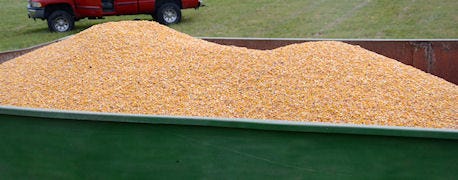
The signs of big corn yields are showing up across Indiana as farmers get deeper into corn harvest. Piles of grain are showing up, and elevator lines are reportedly the longest in some time. In fact, one farmer joked that he could sit in the combine cab and read two books, plus watch a movie while he was waiting on the next truck to get back so that he could unload.
Related: Mountains Don't Belong in the Grain Bin!
It's no wonder. Yield reports of field averages above 200 bushels per acre are common. Seeing 300 bushel and higher spikes on calibrated yield monitors is apparently quite common as well.

High moisture corn: Corn coming out of the field is still carrying reasonably high moisture levels.
One farmer with long rows says his biggest problem is making it across the field without running out of room. It's a problem if you're opening a field. It's also a challenge if you're running strip trials or test plots and don't want to unload onto an auger cart before you reach the end of the field.
One concern is that some corn still coming out of the field isn't all that dry. Moisture levels reported for corn coming out of the field in the past few days range from 18 to 28%.
If corn is coming out wet, be sure to dry it as quick as you can, says Klein Ileleji, Purdue University Extension grain handling specialist. He's concerned that farmers and elevator people who are searching for space don't take shortcuts in storage.
Related: Time to Prevent a Disaster in the Grain Bin
Make sure you have the ability to aerate grain wherever you're putting it, even if it's an outside pile of corn. Otherwise you may be disappointed with spoilage levels and frustrated at trying to remove large amounts of damaged corn when you unload the bin or empty the pile sometime later.
Aeration and drying corn to safe levels before you place it on a pile or in the bin will help prevent problems, he says.
Proper grain handling and storage can help you put more corn in the bin and more money in your pocket. Learn the best Grain Handling and Storage Tips in our new free report.
About the Author(s)
You May Also Like




